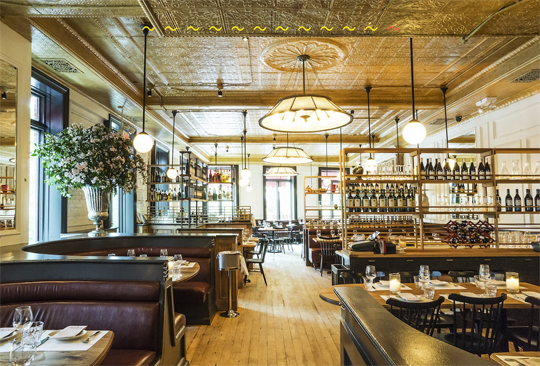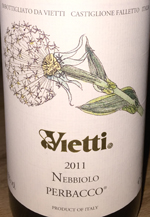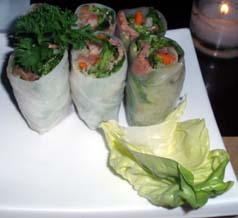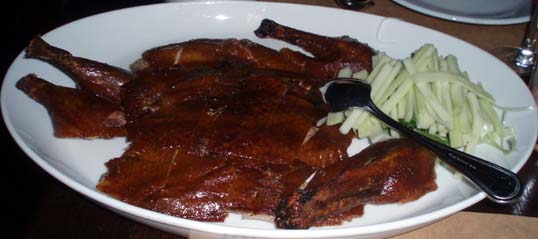

Any popular restaurant must decide how to ration access to its scarcest resource: seats. The two most common strategies are accepting reservations and taking walk-ins—first-come, first-served. Even those basic strategies have variations, from the funky online reservation system at Momofuku Ko, to the transferrable tickets sold at Grant Achatz’s Next.
Some restaurants that take reservations the old-fashioned way—by phone—are in such high demand that a prime-time table is practically inaccessible by normal means. Blue Hill Stone Barns takes reservations two months to the day in advance, and routinely fills up within minutes. You won’t find me anytime soon at Chef’s Table at Brooklyn Fare, the tasting menu at Roberta’s, or the three-day-a-week pop-up Frej, to name a few: there are too many hoops to jump.
Taking walk-ins is said to be more “democratic,” but the hassle we endured recently, just for the privilege of eating at Danji in Hell’s Kitchen, is a reminder that this often isn’t any fun at all.
 At first blush, the door at the Japanese restaurant Bohemian seems more seems more impenetrable than all of these put together. There’s no listed telephone number, and it takes creative googling to find the website, the hopelessly unguessable playearth.jp, which it shares with sister restaurants in Nishiazabu, Japan, and Bali, Indonesia.
At first blush, the door at the Japanese restaurant Bohemian seems more seems more impenetrable than all of these put together. There’s no listed telephone number, and it takes creative googling to find the website, the hopelessly unguessable playearth.jp, which it shares with sister restaurants in Nishiazabu, Japan, and Bali, Indonesia.
It doesn’t appear to be a restaurant website at all. After a few clicks, you find an explanation, and it’s not encouraging: “Please keep in mind that the location and contact info is not open to the public, so please be referred by somone who has already visited us.
“If there are people feeling, ‘I haven’t been there, but I really want to visit!’ please send us a brief introduction of yourself to the email address below. We may contact you to come over!”
I tried the latter, and within an hour had a favorable response by email, which included the “secret” telephone number. A day or so later, I called and secured a Sunday evening reservation, and that was that.
 The system is strange, but try getting someone on the phone at Mario Batali’s Babbo: I remember getting busy signals for weeks, before I finally spoke to a human being. The first time I booked at Per Se, it took 45 minutes to get through—and I had to call exactly at 10:00 a.m. the day that bookings opened for the date I wanted.
The system is strange, but try getting someone on the phone at Mario Batali’s Babbo: I remember getting busy signals for weeks, before I finally spoke to a human being. The first time I booked at Per Se, it took 45 minutes to get through—and I had to call exactly at 10:00 a.m. the day that bookings opened for the date I wanted.
I’m not here to defend Bohemian’s Byzantine ways, only to point out that it’s a lot more accessible than many restaurants that ration access using far more traditional methods. Plenty of folks have cracked the code: Bohemian has a 27/25/28 rating on Zagat.
 Like everything else about Bohemian, the location is not at all obvious: at the back of a long, mysterious corridor fronted by a NoHo butcher shop on Great Jones Street. You ring a doorbell, and if you’re on the list (walk-ins aren’t accepted), the server admits you.
Like everything else about Bohemian, the location is not at all obvious: at the back of a long, mysterious corridor fronted by a NoHo butcher shop on Great Jones Street. You ring a doorbell, and if you’re on the list (walk-ins aren’t accepted), the server admits you.
There are twenty-five seats, most at low-slung tables and sofas, as if you’re the guest in someone’s rec room. We were offered seats at the bar, which might be preferable. It’s a very deep bar, with ample room for placemats and drinks; seating is comfortable.
 Despite various news stories and blog posts describing Bohemian as “private” or “mysterious,” they do not discourage publicity, once you finally get in. Illustrated blog posts, like this one, aren’t hard to find. But most reviewers honor the restaurant’s request not to disclose the address or phone number, as will I, even though neither is all that hard to find.
Despite various news stories and blog posts describing Bohemian as “private” or “mysterious,” they do not discourage publicity, once you finally get in. Illustrated blog posts, like this one, aren’t hard to find. But most reviewers honor the restaurant’s request not to disclose the address or phone number, as will I, even though neither is all that hard to find.
An evening here progresses, more or less, as it would at any restaurant. The izakaya style menu offers various small and medium-size plates, in a wide price range, but not expensive for what you get. (Click on the miniature image above to see more.)
The style of the cuisine might be called fusion, with traditional sushi and sashimi and the ever-present miso black cod, standing alongside “Mac & Cheese,” fresh oysters, and mini-burgers.
We had the six-course tasting menu, which at $55 might be one of the best bargains in town. However, I get the impression it seldom changes, as most of the other reviews I’ve read, featured mostly the same dishes.



The three starters were just fine, though not really memorable on their own: a fresh vegetable fondue (above left), an uni croquette (above center), and assorted cold cuts (above right).

But the entrée was one of the best dishes I’ve had all year, a pan roasted branzini with a bounty of seasonal vegetables, including potatoes, asparagus, olives, onions, garlic, Brussels sprouts, and several others I’ve forgotten. The skin of the fish was nicely crisped, and succulent inside.
We were served the whole fish, which (with the vegetables) was more than we could finish. It shows on the à la carte menu at just $28, which I assume is a half portion.



The fourth course is the only one for which a choice is offered. I had the mini-burger (above left), described as “Washu,” one of the breeds that appears on most menus as “Wagyu.” Served medium rare, it had a rich, fatty taste, served with two fried potato slivers. The other option was the Ikura Caviar Rice Bowl (above center), a dish so luscious it could almost be dessert.
A simple but effective Almond Pannacotta (above right) with black tapioca concluded the evening.
The restaurant was fully booked on a Sunday evening. Our tasting menu progressed at a comfortable pace. With its relatively small dining room, a couple of servers seemed to have no trouble keeping diners fed and lubricated.
The quality of the food took a notable step up mid-way through, with the arrival of the branzino, which was so good that it might almost have been worth $55 all by itself. To pay that for five courses was remarkable.
Bohemian
Food: Traditional Japanese and fusion cuisine
Service: Attentive and personal
Ambiance: The feel of a private club in someone’s home
Rating: ★★
Why? Relaxing and enjoyable. “Secrecy” works to its advantage.
 Tuesday, February 3, 2015 at 05:39PM
Tuesday, February 3, 2015 at 05:39PM 
 I’m still not sure if Andrew Carmellini truly wanted to be the king of middlebrow restaurants, or if he just stumbled on them by accident.
I’m still not sure if Andrew Carmellini truly wanted to be the king of middlebrow restaurants, or if he just stumbled on them by accident. It’s not a crazy idea. Americans have an indistinct relationship with the pasta course: it can serve as an appetizer, or it can be a meal in itself. Very few, in my experience, actually order it as a middle course, between an appetizer and an entrée: it’s just too much food. Still, the menu at Bar Primi is a bit disorienting. It feels like two-thirds of a restaurant, and despite Sutton’s protestations, not exactly cheap.
It’s not a crazy idea. Americans have an indistinct relationship with the pasta course: it can serve as an appetizer, or it can be a meal in itself. Very few, in my experience, actually order it as a middle course, between an appetizer and an entrée: it’s just too much food. Still, the menu at Bar Primi is a bit disorienting. It feels like two-thirds of a restaurant, and despite Sutton’s protestations, not exactly cheap.
































































